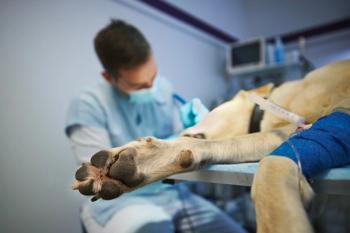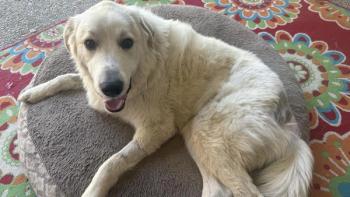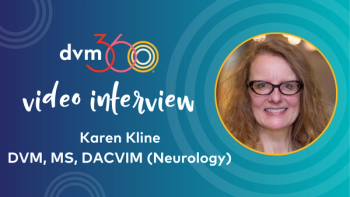
Cranial nerve disorders of dogs and cats (Proceedings)
The trigeminal nerve is a large nerve that contains both motor and sensory components.
Trigeminal Nerve (Cranial Nerve V)
The trigeminal nerve is a large nerve that contains both motor and sensory components. The motor (efferent) portion is contained in the mandibular branch, and it innervates the muscles of mastication (temporalis, masseter, medial and lateral pterygoid, rostral digastricus and mylohyoid muscles). The sensory (afferent) portions of the trigeminal nerve are in the ophthalmic, maxillary and mandibular branches, and are responsible for nociception and proprioception to most parts of the head (face, eyelids, pinnae, cornea, oral cavity and mucosa of the nasal septum).
Testing the Trigeminal Nerve
A. Cutaneous Sensory Testing
1. Corneal reflex
- Touch center of cornea (autonomous zone of the ophthalmic branch) with a moist cotton swab; observe for retraction of globe +/- eye blink
- CN V afferent (ophthalmic branch only), CN VI +/- VII efferent
2. Palpebral reflex
- Touch medial canthus of eye; observe for eye blink
- CN V afferent (ophthalmic and maxillary branches), CN VII efferent
3. Trigeminofacial reflex
- Touch area of maxillary vibrissae, observe for eye blink
- CN V afferent, CN VII efferent
4. Pain responses
- Require cortical processing, CN V is afferent
o Gentle, blunt stimulation of the nasal mucosa on the medial nasal septum causes retraction of the head (cortical response)
o Noxious stimulus to the lateral maxilla at the level of the canine tooth (autonomous zone for maxillary branch of CN V) causes ipsilateral curling of the lip (CN VII efferent part of this reflex) and withdrawal of the head away from the stimulus (cortical response)
o Noxious stimulus to the lateral mandible at the level of the canine tooth (autonomous zone for mandibular branch of CN V) causes withdrawal of the head away from the stimulus (cortical response)
B. Evaluating Motor Function
1. Paresis/paralysis. Ability to close the mouth and prehend food. May be difficult to detect if unilateral
2. Atrophy
3. Symmetry and tone of the muscles of mastication
Clinical Signs of CN V Dysfunction
A. Sensory dysfunction
1. Decreased (hypesthesia, anesthesia)
- Decreased or absent reflexes (palpebral, corneal, trigeminofacial)
- Reduced facial sensation
- Corneal ulcer
2. Abnormal (paresthesia, hyperesthesia)
- Rubbing or pawing at face
B. Motor dysfunction
1. Masticatory muscle paresis or paralysis
- Unilateral—difficult to detect clinically
- Bilateral—dropped jaw, inability to close mouth, drooling, difficulty in prehending food
2. Masticatory muscle atrophy
- Severe neurogenic atrophy (unilateral or bilateral)
Lesion Localization
A. Intracranial
1. Pons and rostral medulla
- Lesions in this area affect both sensory AND motor nuclei –Therefore, motor and sensory dysfunction is present
- Other brainstem signs may also be present such as other cranial nerve deficits (particularly central vestibular signs), paresis, obtundation, conscious proprioception deficits
2. Caudal medulla and cranial cervical spinal cord
- Lesions in this area only affect the sensory nucleus and tract
- Therefore, sensory dysfunction is present WITHOUT motor dysfunction
- Other brainstem signs may also be present
3. Intracranial but extramedullary
- Lesions in this area include the root of the trigeminal nerve, trigeminal ganglion, and trigeminal nerve BEFORE it exits the foramen
- Therefore, motor and sensory dysfunction is present
- Other brainstem signs are usually present
B. Extracranial
Clinical signs vary with the location of the lesion along the trigeminal nerve and the branch(es) involved
Differential Diagnosis
There are only a few diseases that selectively affect the trigeminal nerve. The same DAMNIT-V differential diagnosis list applies when considering diagnostic ruleouts for intracranial diseases and extracranial, cranial nerve diseases. The most commonly recognized categories of diseases affecting the trigeminal nerve are: idiopathic, infectious, neoplasia and trauma.
Diagnosis
1. History (ask about vaccination)
2. Clinical signs
3. +/- Electrodiagnostics (EMG, BAER (brainstem auditory evoked response)
4. MRI preferred over CT
5. CSF analysis
6. +/- Skull radiographs
Most Common Diseases
1. Idiopathic Trigeminal Neuritis (dogs and cats)
2. Infectious - Rabies
3. Neoplasia
4. Trauma
Facial Nerve (Cranial Nerve VII)
The facial nerve has a long interosseous course, a large number of interneural communications and a large number of functions—it is one of the most complex cranial nerves. The main function of the facial nerve is motor innervation to the muscles of facial expression. In dogs and cats, there is a small sensory branch that innervates the skin on the concave surface of the pinna. The facial nerve also supplies taste sensation to the rostral 2/3 of the tongue and carries parasympathetic fibers to the lacrimal and salivary glands.
Testing the Facial Nerve
A. A. Reflexes
1. Menace reaction
- CN II afferent, CN VII efferent
2. Corneal and palpebral reflexes
- CN V afferent, CN VII efferent
3. Trigeminofacial reflex
- CN V afferent, CN VII efferent
B. Evaluating Motor Function
1. Facial symmetry, and symmetry of facial movements
C. Evaluating parasympathetic function
1. Lacrimation
- Evaluate tear production using the Schirmir tear test
D. Cutaneous sensory testing
1. Autonomous zone of facial nerve (dog and cat)
- Fold over the pinna. Touch or gently pinch the inner surface of the pinna in the area of the fold. Observe for the ipsilateral eye to blink, ear movement and a conscious response (turning head, growling, etc).
- CN VII afferent, CN VII efferent, cerebral cortex
2. Pain response
- Lip pinch (CN V afferent, CN VII efferent, cerebral cortex)
E. E. Evaluating special senses
1. Taste
- Evaluate response to tartaric acid placed on rostral 2/3 of the tongue
Clinical Signs of CN VII Dysfunction
A. Motor dysfunction
1. Impaired ear, eyelid, eyebrow and lip movements—DROOPING
- Eye, eyelid
o Widening of the palpebral fissure (paralysis of orbicularis oculi muscle)
o Inability to close the eye or incomplete eyelid closure
- Lip
o Food may accumulate between the teeth and affected cheek
o Drooping of the lips and commissure (acute)
o Contracture of the lips (chronic)
2. Abnormal (decreased or absent) facial reflexes
3. Deviation of the nasal philtrum and planum to the "normal" side
- Nasal philtrum and planum is passively pulled over to the "normal" side due to lack of muscle tone on the "abnormal" side acutely
- Nasal philtrum and planum may be pulled over to the "abnormal" side with chronicity (due to contracture)
4. Lack of nostril flare (especially noted in horses)
5. Facial spasm (rarely noted)
B. Sensory dysfunction
1. Impaired taste
2. Reduced or absent sensation on inner surface of the pinna.
C. Autonomic dysfunction
1. +/- Dry eye and dry nose
Lesion Localization
A. Central facial paresis/paralysis
1. Intracranial—"Supranuclear"
- CN VII upper motor neuron paresis (facial reflexes are normal)
- No changes in taste, salivation or lacrimation
- Other cranial nerve or intracranial signs may be present
- The lesion is "above" or rostral to the motor nucleus of CN VII
2. Intracranial—rostral medulla
- CN VII paresis/paralysis (reduced to absent reflexes)
- Loss of taste sensation
- Loss of lacrimation
- Other cranial nerve and brainstem signs are usually present, particularly CN V, CN VIII and cerebellar signs
- May have a change in mentation
B. Peripheral facial paresis/paralysis
1. Between rostral medulla to the geniculate ganglion
- CN VII paresis/paralysis (reduced to absent reflexes)
- Loss of taste sensation
- Loss of lacrimation
- d. +/- CN VIII signs
2. Geniculate ganglion to stapedial nerve
- CN VII paresis/paralysis (reduced to absent reflexes)
- Loss of taste sensation
- Normal lacrimation
3. Stapedial nerve to chorda tympani nerve
- CN VII paresis/paralysis (reduced to absent reflexes)
- Loss of taste sensation
- Normal lacrimation
- Signs of middle ear disease may be present (+/- vestibular signs, signs of horner's syndrome)
4. Distal to the chorda typani nerve (also called "extracranial")
- Global or partial dysfunction depending on specific lesion and location
- Normal lacrimation and taste
Differential Diagnosis
There are only a few diseases that selectively affect the facial nerve. The same DAMNIT-V differential diagnosis list applies when considering diagnostic ruleouts for brainstem diseases for central facial nerve disease and peripheral cranial nerve diseases for peripheral facial nerve disease. The most commonly recognized categories of diseases affecting the facial nerve are: idiopathic, infectious, neoplasia, trauma, metabolic and inflammatory. Facial nerve deficits are also noted commonly in animals with motor unit disease.
Diagnosis
1. History
2. Schirmer tear test, taste test
3. Clinical signs
4. Complete minimum database
5. +/- Electrodiagnostics (EMG, NCV (possible but difficult), BAER (brainstem auditory evoked response)
6. Advanced imaging (MRI preferred over CT, -+/- Skull radiographs (not very sensitive)
7. CSF analysis
8. Otoscopic examination
Most Common Diseases
1. Idiopathiic Facial Nerve Paralysis
2. Infectious - Otitis media-interna
3. Neoplasia
4. Trauma
5. Metabolic
6. Inflammation
Newsletter
From exam room tips to practice management insights, get trusted veterinary news delivered straight to your inbox—subscribe to dvm360.






